El Escorial is a massive royal complex in Spain, once the center of Spanish government and royal life. It is one of the largest palaces in the world, and, today, it is one of the most popular tourist attractions in Spain.
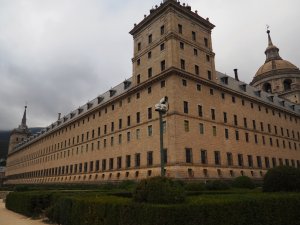
Since I was in high school, I have wanted to visit El Escorial. I vividly remember seeing a photo of the palace in my hefty art history textbook, Gardner’s Art Through the Ages, and wondering how I’d never heard of this massive, historic structure. For years, I’ve wanted to see it for myself. I finally did. And I took a lot of notes.
Here’s everything you need to know (and a little extra) for the best experience visiting El Escorial in Spain:
Contents
What is El Escorial?
Simply put, El Escorial is a massive Spanish royal complex. Officially, the name is Real Monasterio de San Lorenzo de El Escorial (Royal Monastery of San Lorenzo de El Escorial). In its prime, it was an important center for all things Spain. That included government, health, education, religion and, of course, royalty. The exterior of El Escorial is impressive in magnitude, but it’s not especially fancy. The interior is another matter, but the outside exudes a feeling of strength and power rather than wealth and frivolity.

In its present form, El Escorial is the brainchild of Phillip II, King of Spain in the 16th century (1556-1598). Phillip’s creation is essentially a royal excuse to commemorate a military victory. It took more than 20 years for the enormous complex to be completed. The site of El Escorial was previously home to a monastery and school.
El Escorial was one of the primary residences of Spanish monarchs for centuries. Historically, the complex served as an educational institution, hospital, royal burial site and religious center. Today, the site functions as a museum, basilica and monastery. El Escorial royal complex and monastery is also home of the royal crypt of Spanish monarchs and the final resting place for many other members of the Spanish royal family.
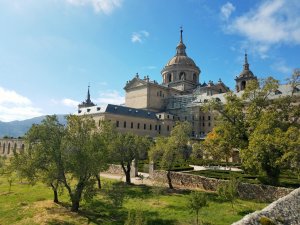
El Escorial is located in the foothills of the greater Central System mountain range of Iberia. Centuries ago, the location would have been ideal, close to Madrid and still central to Spain, but protected by mountains on one side and sweeping views on the other. It is about 25 miles northwest of Madrid but feels much farther away.
Transportation – How to Get to El Escorial?
The best way to get to El Escorial from Madrid is via car. Depending on traffic, the trip takes about an hour. With a car, you’re free to stop at any of the alluring sights along the way, and you’re free to explore the royal complex and town on your own time. However, renting a car and driving in a foreign country is not for everyone.
The easiest way to reach El Escorial from Madrid is via train. And the simplest way to reach the massive royal complex is to take the train (C-3a) from stations Madrid Puerta de Atocha or Madrid Chamartin. The trip takes an hour and costs about €7 each way.
After the train arrives in El Escorial, the royal complex is about a 20-minute walk from the station. Don’t worry about getting directions. The structure is so large that you’ll see it.
How Long Does a Visit Take?
It’s difficult to adequately express the magnitude of the El Escorial complex. It’s absolutely huge, one of the world’s largest royal/formerly royal structures. Judging by sheer size alone, it would take days to thoroughly explore all the nooks and crannies of El Escorial.
Naturally, though, most of El Escorial is not open to visitors. It is still a functioning monastery, among other uses, and many sections are off limits. Even with large portions of the complex closed to visitors, it is so large that the areas that are open take a long time to peruse.

Simply walking through the open portions – that is, paying no attention to anything when visiting El Escorial and going through the motions – will take a couple of hours. This would be a gross injustice and, honestly, a waste of a ticket. This building is worth taking the time to explore.
I understand that history and art is not at the forefront of every traveler’s mind, but that’s what this building entails. My primary focus as the Hangry Backpacker is always local food and drink, but I am fascinated by history, art and architecture. For travelers whose interests lie outside of art, history and architecture, don’t waste your time visiting El Escorial.
A thorough visit to this landmark attraction through all of the open areas, perusing the art, taking a few photos and appreciating the magnitude of the surrounding history will take at least 3-4 hours.
Visiting El Escorial – When?
El Escorial is one of the most visited tourist sites in Spain. More than half a million people visit the royal and religious complex of El Escorial each year. Despite these large numbers, the size of the structure easily disperses crowds.
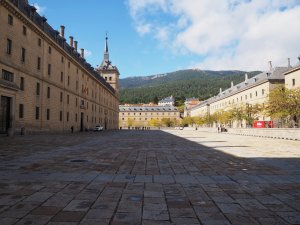
Summertime will see the highest volume of visitors. If you’re visiting during this period, try to go on a weekday. Even though the weekend crowds are nothing compared to a slower offseason day at a place like Seville Cathedral, visiting a popular attraction is always more enjoyable with smaller crowds.
El Escorial sits at an elevation over 3000 feet above sea level. If you’re a lifelong flatlander like myself, take your time climbing the steps of the complex and take it easy on the hills in town.
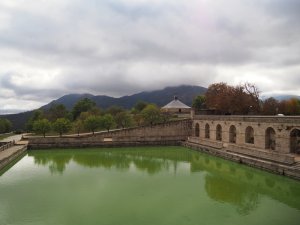
The elevation of El Escorial, and the location in the foothills of the Guadarrama Mountains, means Winter will be cold. While the town does not see so much snowfall as nearby higher areas, it happens. I’m sure El Escorial is beautiful in the snow, but there’s no sense in freezing your ass off to play tourist. That definitely doesn’t sound like much fun to me.
The best time to visit El Escorial is in the Spring or Fall. The weather is pleasant and the crowds are smaller than in the peak season. The royal and religious complex closes at 6PM in Fall/Winter and 8PM in Spring/Summer. Plan to arrive early enough to avoid a truncated visit.
Additional Tips
Tickets
Tickets to El Escorial are €12 for regular adults. There are discounts for seniors (65+), children and students (25 and under). An audio guide costs €3.
Don’t worry about buying tickets beforehand. It’s not like visiting the Alhambra in Granada. Tickets are easily and quickly purchased at the ticket office on site.
Photos
Photography, much to my chagrin, is prohibited in much of El Escorial. There are certain areas where photos are permitted, and there are other areas where – well, let’s just say there is no one to yell and harass harmless tourists in every corner of the massive compound.
Either way, flash photography is certainly (and understandably) prohibited. The takeaway from these rules is that you’re wasting time and energy by hauling around a bunch of equipment. Leave it secured at the hotel. It might be easy to snap a quick pic with a cell phone or small camera, but no one is fooled by that extra large lens, selfie stick or tripod.
Skip the Group Tour
Please don’t pay for a tour. I know a day trip from Madrid appears hassle-free, but it’s nothing more than a tourist racket.
I did a quick search of tour operators to El Escorial and they are crazy expensive. Most tour operators charge at least €75 per person for transport from Madrid and entrance to the royal complex. The median price is over €100. That’s nothing more than ripping off naive tourists.
It’s really easy to reach El Escorial on your own, and the total cost, including transportation and admission is less than €30. Don’t waste time or money on a group tour.
Hora de la Siesta?
The towns sandwiched around the royal palace and monastery, San Lorenzo de El Escorial and El Escorial (town), are small cities with a few thousand residents each. Small cities in Spain are sleepy, in good and not-so-good ways.

Small Spanish towns are quaint and charming and all that cutesy stuff. They’re also sleepy. But not in the attractive way. These smaller cities are more likely to partake in a siesta in some form. In the two cities adjacent to the El Escorial complex, things definitely shut down for a bit in late afternoon. Especially in the lower season.
If you are thinking about wandering around these towns before or after your visiting El Escorial, plan accordingly. Prepare for the possibility of many shops closing in the late afternoon. During Summer peak season, with more visitors and business, shops may stay open longer.
During my visit (early Fall), San Lorenzo de Escorial was a ghost town. It looked more like a town of 180 instead of 18,000. Looking for a place to eat after visiting the palace was a challenge. Most restaurants were closed. Those that were open were operating with a skeleton crew.
Bags
Large bags are not allowed in El Escorial and must be left behind or put in a locker. My day bag, a really small backpack with no bulky or protruding parts, was deemed too large even though it is smaller than some of the purses other visitors were slinging around.
Lockers for your bags are free and secure. Despite this, never leave your valuables behind.
The communication that my bag was “too large” was unclear. No one told me so, and I was already 20 minutes into touring when I was stopped. I had to go all the way back to the entrance and lock it away. Apparently, there is a small sticker put on bags at the entrance to identify the ones that are “too large.” In hindsight, I could have taken the sticker off of my borderline-too-big backpack and kept it with me.
Hangry Backpacker Favorites
Royal Pantheon
The Royal Pantheon is the historical highlight of visiting El Escorial. Of all the intricate and elaborate tombs and crypts I’ve seen, this may be the most impressive. The Royal Pantheon is down a staircase in a cool, cave-like room. There are ornate marble coffins, four-high, lining the walls around the room.
How can you not like this place? This room has a powerful silence that reigns supreme over the final resting place of the former reigning monarchs of Spain. As beautiful as it is, I have no doubt it is an eerie place at night.
The Royal Pantheon of El Escorial is probably the most controlled part of the complex. The number of visitors inside is regulated, with photos, noise and touching strictly prohibited. There’s a reason it’s so highly controlled and monitored. The amount of power and history buried in this crypt is staggering.
Hall of Battles
I’m not usually a rule breaker, but I have to admit that I find photography restrictions in many places unnecessary. I’m fine with a no flash photography rule – that makes sense! – but restrictions on taking cell phone videos or snapping a few flash-free, non-professional photos of old artwork, ceilings or whatever is not going to harm the items.
I think one of the main reasons museums and other historic places ban photography in the name of “preservation” is that it encourages visitors to buy the expensive photography books in the gift shop.
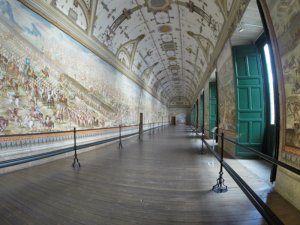
All of that being said, like so many visitors, I can’t help sneaking the occasional photo when I’m not supposed to. Sometimes the temptation is too great. I never use flash, and I like to think I’m pretty stealthy.
In El Escorial, I managed to sneak a few photos in areas where it was not allowed, specifically the Hall of Battles. I couldn’t help it. This room is a fascinating display of Spanish history and the beauty that hides within the palace.
The Hall of Battles in El Escorial is fascinating. It depicts important Spanish military victories from the 15th and 16th centuries. The battle scenes are presented in incredible detail on frescoes that stretch from one end of the room to the other. It must be nearly 200 feet long.
Royal Library
The Royal Library in El Escorial may be the most beautiful room in the entire complex. Especially as an ardent student and lover of geography, this room was one of my favorite places in the royal complex. The Royal Library is full of old books, maps and globes.
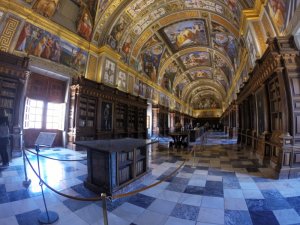
I would love to skim through the globes and maps in here (with a translator, of course) and look at the evolution of cartography. The Royal Library would also make for a fascinating place to enjoy a cigar and a dram of single malt. Perhaps in another life!
El Escorial is a great day trip from Madrid. Personally, I was able to check something off my bucket list. From an historical perspective, this is one of the most important sites in Spain. The royal palace and monastery complex is worth a visit for any traveler interested in art, architecture or history.
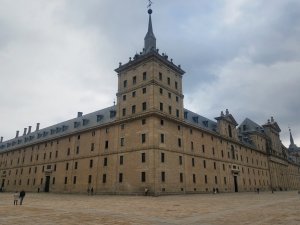
If you have any further questions about visiting El Escorial, send us an email or leave a comment below!
Hola
Where can I leave my suitcase when visiting El Escorial monastery.
I travel by train.
Thanks
Dalia
Hi Dalia, it depends how much luggage you have. But there are lockers for bags and personal belongings on site. I cannot be certain if you can store large suitcases, though.